Add this eBook to your basket to receive access to all 1,364 records. Our indexes include entries for the spelling rhodes. In the period you have requested, we have the following 1,364 records (displaying 1,121 to 1,130): These sample scans are from the original record. You will get scans of the full pages or articles where the surname you searched for has been found. Your web browser may prevent the sample windows from opening; in this case please change your browser settings to allow pop-up windows from this site. Boys entering Haileybury College, Hertfordshire
(1902)
Haileybury College, near Hertford, was founded by the East India Company in 1806, and incorporated by Royal Charter in 1864. This register of pupils entering the school from 1862 to 1931 was edited by a master there, Laurence Arthur Speakman. The boys are listed by term of joining the school, and then alphabetically by name (in bold), surname first (in capitals). There is then usually a precise birthdate, and the name and address of his father; his period at the school, starting with abbreviations to indicate the house to which he belonged (B., Batten; B. F., Bartle Frere; C., Colvin; E., Edmonstone; Ha., Hailey; Hi., Highfield; L., Lawrence; Le B., Le Bas; M., Melvill; Th., Thomason; T., Trevelyan), and the first and last forms attended (e. g., IV., fourth form). Where a member of a school team there is then an indication (e. g., XI., cricket). For some pupils, with whom the school had lost touch, Speakman was only able to record the details of their time at Haileybury; but for most a brief career synopsis is then given, and current address (as in 1931) or date of death.
| Sample scan, click to enlarge
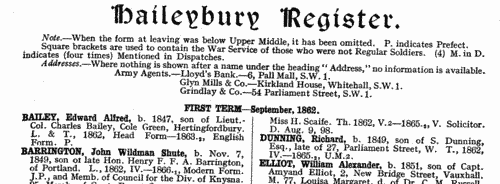
| Boys entering Marlborough College
(1902)
The public school at Marlborough in Wiltshire was founded in 1843. In 1952 this, 9th, edition of the college register was published, being a revision by L. Warwick James of the 8th edition (of 1936): but for the years before 1936 it does not merely repeat the 8th edition, because Warwick James was able to correct the 19th-century entries with information from newly-discovered letters and books from 1843 to 1853, and the school lists from 1844 onwards. The roll is arranged by year, and within each year by term of entrance, and then alphabetically by surname within each term. Each boy is assigned a number within the year: then his name is given, surname first, and, in brackets, his house. The houses within the college were called B1, B2, B3, C1, C2 and C3, and the Lower School (L Sch); the out college houses were Preshute, Priory, Cotton, Hermitage, Littlefield, Barton Hill, Summerfield and Upcot. Then there is given the boy's father's name (surname and initials) and address (at entrance), the boy's date of birth (b) and month of leaving (l). Where the boy represented the school at Rugby football (XV) or cricket (XI), in the rifle corps (VIII, or RC XI), that is indicated. There is a brief summary of achievements in later life, and, where known, and date of death or (in italics) address as in 1952. | Sample scan, click to enlarge
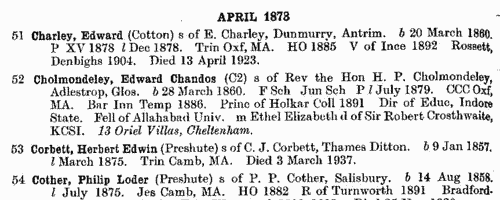
| Boys entering Harrow School
(1903)
This Second Volume of the Second Series of the Harrow School Register was edited by J. H. Stogdon and published in 1925. The boys are listed by term of entrance, and then alphabetically by surname and christian names (in bold). Next, in brackets and in italics, is the school house to which he belonged - or, H. B. indicating a day boy whose family lived in Harrow. Stogdon then gives the father's surname and initials, and address. In cases where the boy was prominent in sports at school, or won academic prizes, scholarships &c., that is given; then the year of leaving the school; a synopsis of his career; and, where known, his address as of 1925, in italics. | Sample scan, click to enlarge
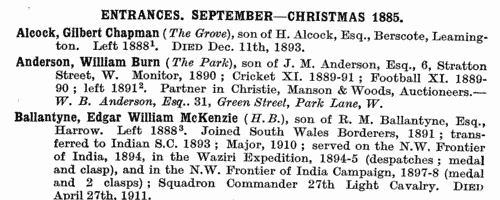
| Eminent Lancashire Clergymen
(1903)
The Contemporary Biography in 'Lancashire at the Opening of the Twentieth Century' was edited by William Thomas Pike. After opening with the most eminent men in the county, there are twelve sections, dealing with Nobility, Gentry and Magistrates; Clergy; Volunteers; Medical Men; the Legal Profession; Art, Music, Literary and Scholastic; Commercial; Dental; Architects, Engineers and Surveyors; Accountants, Auctioneers, Estate Agents, Insurance, &c.; Veterinary Surgeons; and an Obituary. Each biography usually (but not invariably) has a photograph; full name (surname first, in bold; christian name(s) in capitals) and address; birth place and date; father's name (and sometimes details); a short biography; whether married, with wife's name and her father's name and address. | Sample scan, click to enlarge
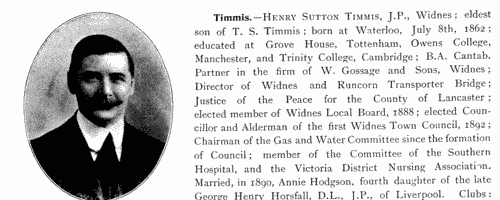
| Member of the North-East Coast Institution of Engineers and Shipbuilders
(1903)
This membership list, as of July 1903, is divided into four grades - Honorary Members, Members, Associates and Graduates. In each case the full name (or name and initials) is given with personal or business address, and month of election to that grade, and to the lower grades. The list is annotated with these abbreviations: A., Agent and Accountant; B. B., Boiler Builder; C. E., Civil and Consulting Engineer; E., Engineer and Boilermaker; E. A., Engineering Agent; E. E., Electrical Engineer; F., Iron and Brass Founder; F. M., Forge Master; I. & S. M., Iron and Steel Merchant or Manufacturer; M., Merchant; M. S., Marine Superintendent; N. A., Naval Architect; R. M., Rope Manufacturer; S., Shipbuilder; S. O., Ship Owner; SUR., Engineer & Ship Surveyor. | Sample scan, click to enlarge
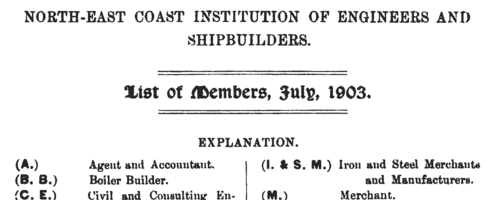
| Victoria University (Yorkshire College) Honours in Chemistry
(1891-1904)
Leeds University Calendar for the academic year 1910 to 1911 includes lists of honours gained in each subject for 1891 to 1904, that is, in the period of Victoria University (Yorkshire College). Full names are given, surname first, with year and class of examination. | Sample scan, click to enlarge

| Associate Members of the Institution of Civil Engineers
(1904)
The Institution of Civil Engineers was established 2 January 1818, and incorporated by royal charter 3 June 1828. The annual report lists the names and addresses (throughout the world) of the four classes of member - members (M. Inst. C. E.), associate members (Assoc. M. Inst. C. E.), associates (Assoc. Inst. C. E.), students (Stud. Inst. C. E.) - with the dates of admission. This is the index to the Associate Members. The symbols at the left of each page are * for Former Students, + for contributors of papers published in the Minutes of Proceedings, or of an Engineering Conference Note; F for a deliverer of a James Forrest Lecture; L for a deliverer of one of the Special Series of Lectures; and various letters for recipients of certain medals and prizes - B, Bayliss Prize; C, Crampton Prize; f, James Forrest Medal; H, Howard Quinquennial Prize; J, Joule Medal; M, Miller Scholarship; m, Miller Prize; italic m, Manby Premium; S, George Stephenson Medal or Prize; T, Telford Premium; t, Telford Premium; italic t, Trevithick Premium; and W, Watt Medal. Those elected prior to 2 December 1878 had been transferred into this class by the Council. | Sample scan, click to enlarge
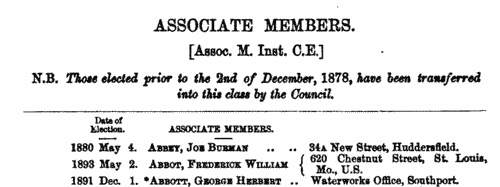
| Associates of the Institute of Bankers
(1904)
The Journal of the Institute of Bankers for 1904 includes a list of Fellows (from which this scan is taken: an asterisk indicates a Life Fellow), of Associates (an asterisk indicates a Life Associate, and a dagger a holder of the certificate of the institute), and of Ordinary Members; there are also results of the institute's final examinations held from 11 to 13 April, in which the successful candidates are listed alphabetically by surname and full christian name(s), with the name and address of their bank (not their personal addresses). These final examinations entitled the successful candidates to the Certificate of the Institute of Bankers; those who obtained distinctions are so indicated in the lists (an asterisk for Commercial Law, dagger for Arithmetic and Algebra, double dagger for Practical Banking, double s for Commercial Geography and History, and double vertical line for Political Economy). There was also an examination taken after the Gilbart Lectures, with successful candidates being awarded money prizes, or certificates of distinction, or honour, or merit, and similar lists of these awards were also printed in the journal. | Sample scan, click to enlarge

| Boys entering Manchester Grammar School
(1904)
This Biographical Register of Old Mancunians lists boys alphabetically by year of entering the school. A bare register of entrants existed from 1888 onwards but it was only since the Second World War that any kind of detailed record was kept of those who passed through the school. So, in every case in this printed register, full name is given, in bold, surname first (in capitals); date of birth, and years attending the school; but for the earlier years sometimes there is no more information - or, equally, after investigation among Old Mancunians and published sources, the editors may have been able to furnish a condensed biography. An asterisk indicates a holder of a Foundation Scholarship. In the later years a current address is also given, as of 1964 to 1965, when the book was prepared. | Sample scan, click to enlarge
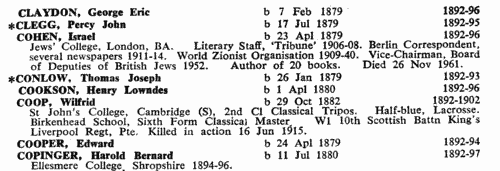
| Indian Civil Servants
(1904)
The India List and India Office List was compiled from official records by direction of the Secretary of State for India in Council, and published by the India Office annually. The volume for 1905 includes this Record of Services, corrected to 1 July 1904. It includes Officers of the Home Establishment of the Secretary of State, Officers of the Covenanted Civil Service, and those appointed under the Native Civil Service Rules, other Officers in Civil Employment in India whose substantive pay was at least 1000 rupees a month, and, with a few exceptions, all officers of those classes who had retired since 1886. | Sample scan, click to enlarge

|
Research your ancestry, family history, genealogy and one-name study by direct access to original records and archives indexed by surname.
|











